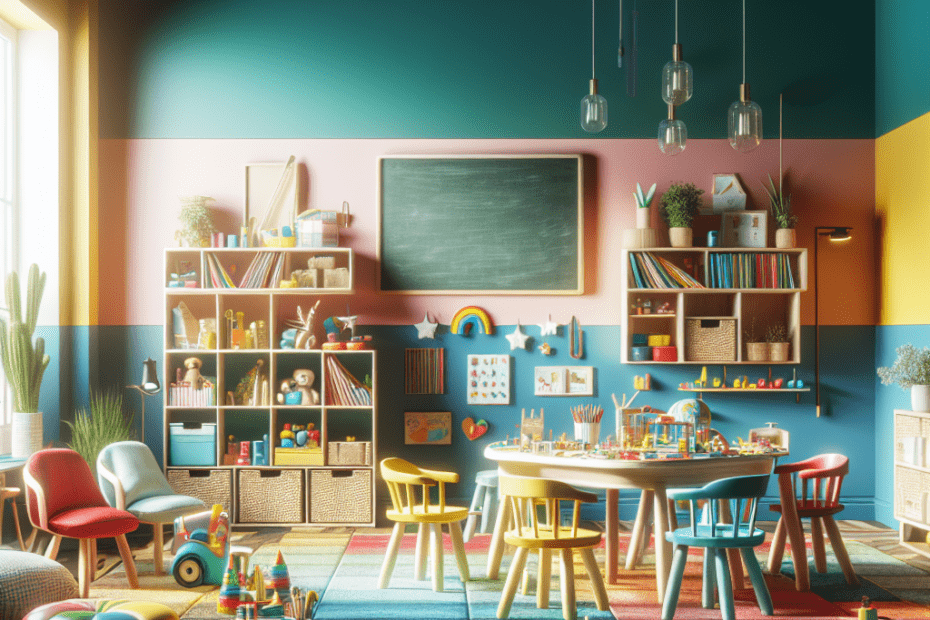Their journey into designing a playroom with vibrant colors and playful furniture begins with a mission to create a captivating and engaging environment for children. When aiming to strike a balance between functionality and creativity, they can rely on a handful of playroom design tips tailored to spark imagination and offer comfort. By integrating colorful decor, fun furniture, and space-saving solutions, they can craft a playroom that becomes the centerpiece of joy for kids. This blog post explores essential strategies for effective playroom design, complete with statistical insights and practical recommendations.
Vibrant Colors: More Than Just Aesthetic
Utilizing an array of vibrant colors in a playroom isn’t solely for aesthetics—it plays a crucial role in a child’s development. Colors can influence mood, stimulate creativity, and enhance cognitive skills. According to a study by the University of Alberta, exposure to bright colors can boost a child’s creativity by up to 15% (University of Alberta).
They should consider incorporating an array of shades to cater to different emotional responses. For instance, yellow is known to inspire positivity, blue creates a calming effect, and red can energize and excite. An accent wall or colorful mural can serve as a visual focal point, sparking curiosity and imagination.
Emphasizing on Fun Furniture
Playroom design tips often stress the importance of furniture that combines fun with functionality. They can look for uniquely designed pieces, such as bean bag chairs, modular shelving, or interactive tables, which can double up as storage solutions. Such choices help in maintaining an organized and clutter-free environment.
Statistics from the Global Play Furniture Market report indicate a rise in demand for multifunctional furniture, with a predicted compound annual growth rate of 6.5% through 2027 (Market Research Future).
Designing Activity Zones
A well-planned playroom should incorporate designated spaces for different activities. They can create various zones, such as a reading nook, an arts and crafts corner, and a play area, each encouraging a different mode of interaction and learning. This approach helps children understand the importance of organization and the purpose of each space.
They can use rugs or floor mats to visually delineate these zones, adding both comfort and style while defining space clearly.
Lighting and Safety: Ensuring a Safe Play Environment
Lighting plays a pivotal role in making a playroom feel welcoming and safe. It’s essential to prioritize ample natural light, but they should also integrate adjustable lighting options that cater to different times of the day and activities.
Safety remains paramount when designing a playroom. They should secure furniture to the walls, use non-slip rugs, and ensure that all materials are non-toxic and child-friendly.
Infusing Educational Aspects
Incorporating educational elements into the playroom’s design can seamlessly merge learning with play. They can use alphabet or number wall decals, world maps, or interactive chalkboard walls that encourage learning in a fun environment. The NAEYC asserts that play-based learning can enhance children’s development by fostering communication, social, and problem-solving skills (National Association for the Education of Young Children).
| Design Element | Benefits |
|---|---|
| Vibrant Colors | Stimulates creativity and boosts mood |
| Fun Furniture | Enhances functionality and organization |
| Activity Zones | Provides structure and distinct areas for play |
| Safe Lighting | Increases visibility and safety |
| Educational Elements | Encourages learning through play |
Key Takeaways
- Integrating vibrant colors supports creativity and cognitive development.
- Fun and functional furniture is essential for an organized playroom.
- Designing zones helps structure activities and optimize space use.
- Ensuring proper lighting and safety measures is a priority.
- Educational elements enhance learning opportunities in a playful setting.
FAQ
-
What colors are best for a playroom?
Bright colors like yellow, blue, and red are excellent choices as they can influence mood and stimulate creativity.
-
How can they make a small playroom appear larger?
Utilizing multi-functional furniture and creating defined zones can help make the space appear more organized and spacious.
-
What safety features should they include in a playroom?
They should secure heavy furniture to walls, use non-slip rugs, and ensure all materials are non-toxic and child-friendly.
-
Are there any must-have furniture items for a playroom?
Bean bag chairs, modular shelving, and interactive tables are popular choices for their versatility and fun design.
-
How can they encourage educational play?
Incorporating alphabet decals, maps, and interactive walls can promote learning in a natural, playful setting.
With these well-informed playroom design tips, they can ensure any playroom is vibrant, functional, and a haven for learning and creativity.
